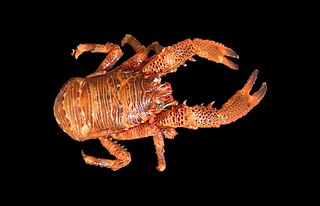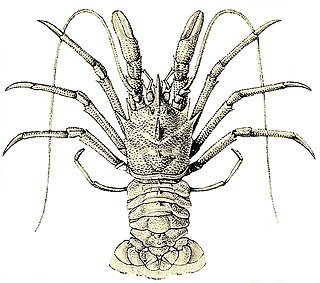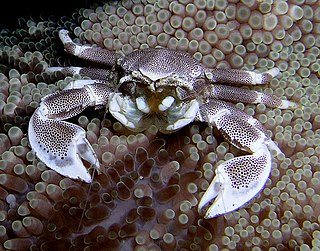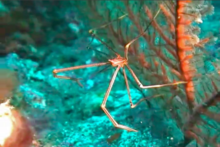
Squat lobsters are dorsoventrally flattened crustaceans with long tails held curled beneath the cephalothorax. They are found in the two superfamilies Galatheoidea and Chirostyloidea, which form part of the decapod infraorder Anomura, alongside groups including the hermit crabs and mole crabs. They are distributed worldwide in the oceans, and occur from near the surface to deep sea hydrothermal vents, with one species occupying caves above sea level. More than 900 species have been described, in around 60 genera. Some species form dense aggregations, either on the sea floor or in the water column, and a small number are commercially fished.

Galathea is a genus of squat lobsters in the family Galatheidae. It is one of the largest genera of squat lobsters that in 2008 contained 73 species. Most species of Galathea live in shallow waters.

Munidopsis serricornis is a species of squat lobster. It is widely distributed in the world's oceans, being found in the eastern Atlantic Ocean, the western Atlantic Ocean, and the Indo-Pacific. It grows up to a carapace length of 20 millimetres (0.8 in).

Galathea strigosa is a species of squat lobster in the family Galatheidae. It is found in the northeast Atlantic Ocean, from the North Cape to the Canary Islands, and in the Mediterranean Sea and Red Sea. It is edible, but not fished commercially. It is the largest squat lobster in the northeast Atlantic, reaching a length of 90 millimetres (3.5 in), or a carapace length of 53 mm (2.1 in), and is easily identified by the transverse blue stripes across the body.

Munidopsis is a genus of squat lobster. It is the second largest of all the genera of squat lobsters, after Munida, with over 200 species. Its members are mainly found on continental slopes and on abyssal plains. A few fossil species are also known, including specimens from the Campanian (Cretaceous).

Eumunida is a genus of squat lobsters. The majority of its species are from the Pacific Ocean and are as follows:
Nanogalathea is a genus of squat lobster from the Bay of Bengal. Two species in the genus Nanogalathea.
Hapaloptyx difficilis is a species of squat lobster in a monotypic genus in the family Chirostylidae.
Gastroptychus is a genus of squat lobsters in the family Chirostylidae, containing the following species:
Uroptychodes is a genus of squat lobsters in the family Chirostylidae, containing the following species:
Fennerogalathea is a genus of squat lobsters in the family Galatheidae, containing the following species:

Galacantha is a genus of squat lobsters in the family Munidopsidae, containing the following species:

Heteronida is a genus of squat lobsters in the family Munididae. They occur in the western Pacific Ocean.

Raymunida is a genus of squat lobsters in the family Munididae, containing the following 11 species:

The Galatheoidea are a superfamily of decapod crustaceans comprising the porcelain crabs and some squat lobsters. Squat lobsters within the three families of the superfamily Chirostyloidea are not closely related to the squat lobsters within the Galatheoidea. The fossil record of the superfamily extends back to the Middle Jurassic genus Palaeomunidopsis.

Chirostyloidea is an anomuran superfamily with squat lobster-like representatives. It comprises the three families Chirostylidae, Eumunididae and Kiwaidae. Although representatives of Chirostyloidea are superficially similar to galatheoid squat lobsters, they are more closely related to Lomisoidea and Aegloidea together forming the clade Australopoda. No fossils can be confidently assigned to the Chirostyloidea, although Pristinaspina may belong either in the family Kiwaidae or Chirostylidae.
Munidopsis echinata is a species of squat lobster, first found in deep waters off Taiwan. M. echinata is similar to M. colombiana, but differs by lacking an antennal spine on its carapace and having a rather longer antennal peduncle.
Eumunida chani is a species of chirostylid squat lobster first found in Taiwan. This species can be distinguished by its absence of a pad of densely distributed setae on its first pereopod, the anterior branchial margin which bears two spines, and the carpus of its first pereopod carrying only two spines.
Uroptychus anatonus is a species of chirostylid squat lobster first found in Taiwan. U. anatonus and U. anacaena are similar but can be distinguished from each other by the shape of their 4th sternite and the length of their antennal scale. Both species resemble U. maori and U. brucei, but lack a ventral subterminal spine on their first pereopod's ischium.
Uroptychus singularis is a species of chirostylid squat lobster first found in Taiwan. This species is distinguished from U. australis by its single, unpaired terminal spine on its flexor margin of pereopods 2–4.








